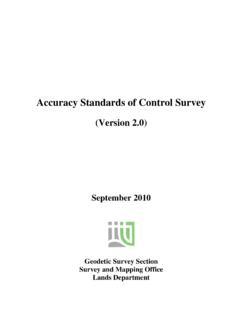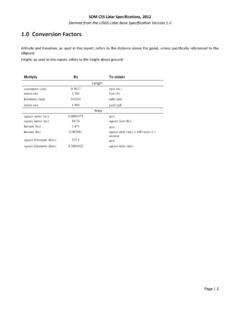Transcription of AZIMUTHS IN CONTROL SURVEYS - Terrasurv
1 John Hamilton 1 geodetic Engineer 412-341-5620 AZIMUTHS IN CONTROL SURVEYS ABSTRACT With the advent of GPS for CONTROL surveying, a problem has arisen. Many existing CONTROL stations established by conventional methods ( first order triangulation stations) are in locations not suitable for direct occupation by GPS equipment. Eccentric observations are often possible, with the eccentric station located up to 100 m away. In order to connect the eccentric station to the main station, an azimuth is necessary. Occasionally, a companion GPS station is set, and the angle is measured. More often, it is necessary to observe an astronomic azimuth . Various methods are explored for determining azimuth , with a discussion of the theory of each method, equipment and procedures, and accuracy attainable.
2 The different methods examined include astronomic, gyrotheodolite, azimuth pairs by GPS, and use of azimuth marks. Existing Standards and Specifications address the issue of AZIMUTHS only in the context of controlling traverses and triangulation networks, with accuracies of to 2 the goal. This paper addresses the issue of lower accuracy AZIMUTHS , in the range of 5 to 20 . Also discussed is the difference between astronomic, geodetic , and grid north. A discussion is made for potential inclusion in the "Input Formats and Specifications of The National geodetic survey Data Base" of the different types of AZIMUTHS besides the presently accepted polaris azimuth , when the distances are short and the required accuracy is lower. INTRODUCTION Over the years, various methodologies have been used to obtain azimuth CONTROL when extending horizontal CONTROL whether by traverse or triangulation.
3 In the eastern part of the US, old photographs show that in the early part of this century, much of the area had few trees, having been timbered and cleared for farming. Many of the triangulation stations, located on high hilltops, had good visibility to an adjacent station or at least to an azimuth mark. Over the years, most of the rural areas have reforested, and the urban areas have become built up. It is a rare occurrence now that a recovered 1st order station has any kind of available ( visible from the ground) azimuth reference. This was probably one of the main reasons why local surveyors often did not make ties to this CONTROL . Instead, many SURVEYS used assumed datums with assumed AZIMUTHS . Some surveyors simply backsighted the nearby reference marks, thereby introducing large errors into their SURVEYS .
4 When GPS arrived in the mid 1980 s, there was precious little satellite coverage in a day. When establishing a survey network to be used by conventional equipment, the clients often specified that an intervisible azimuth mark was to be established. Because of the high cost of GPS equipment and the short GPS window, usually stations were established individually, and astronomic observations were then made at some or all of the stations to establish azimuth marks. Now, with 24 hour coverage and shortened observation times, stations are frequently established in pairs. Still, it is not always possible to set an intervisible station a sufficient distance away in a location that is suitable for GPS. John Hamilton 2 geodetic Engineer 412-341-5620 Before the establishment of HARN (High Accuracy Reference Network) stations, it was necessary (and still sometimes is) to use existing triangulation stations for CONTROL , which are often located in wooded or otherwise obstructed locations.
5 The NGS (and its predecessor, the USC&GS) utilized Bilby towers, ranging in height up to 110+ feet, to achieve intervisibility between main scheme stations. At many of these stations, although a direct occupation is not possible, it is possible to locate an eccentric GPS station less than 50 meters away. This necessitates observing an astronomic azimuth between the eccentric and the existing station. Another common situation is when a survey station, for example a property corner, is not occupiable by GPS, but it is possible to establish a GPS station nearby. The Federal geodetic CONTROL Committee (FGCC, now FGCS) specifications for conventional CONTROL SURVEYS , last updated in September 1984, do not specifically address these situations.
6 However, the document does specify that Astronomic AZIMUTHS are required every X number of segments in a traverse, and X number of triangles in a triangulation network, depending on the order of the survey . The AZIMUTHS are implied to be polaris AZIMUTHS (or other star) by the Observations per Night and Number of Nights criteria, as well as the standard deviation ( for first order up to for third order) required. While this accuracy is certainly important for controlling extensive traverse/triangulation nets, it is much higher than necessary for a short eccentric reduction. The difficulty of working at night, and the unfamiliarity of using Polaris had the following effects: assumed datums, because the surveyor did not have survey orientation to start and end the survey , and therefore did not use the geodetic CONTROL use of nearby (inaccurate) reference marks for azimuth CONTROL assuming an azimuth for a traverse starting leg, then rotating the entire traverse to fit the ending coordinates, sometimes including angular blunders in the network use of intersection stations (which are third order, and may be subject to movement) having to go much further for CONTROL for GPS, or using lower order stations All of these resulted in survey networks which were less (sometimes much less) accurate than would have otherwise been possible.
7 The purpose of this paper is to review the concepts for determining AZIMUTHS , particularly astronomic methods, and to give an idea of the accuracies and complexities of each method. The azimuth accuracy required at a distance of 30 m to achieve an accuracy of m is 20 , which, as will be shown, is easily obtained using any visible object in space, whether polaris, other stars, sun, moon, or planets, when proper observational and computation procedures are followed. What follows is often a simplification, appropriate to the accuracies discussed. Corrections applied to first order AZIMUTHS , such as polar motion, and diurnal aberration, are not considered. John Hamilton 3 geodetic Engineer 412-341-5620 WHAT IS AN azimuth ? An azimuth is defined as a horizontal angle reckoned clockwise from the meridian.
8 There are several types of "north". Astronomic north is with respect to the astronomic meridian, which varies from point to point in an irregular manner under the influence of gravity. geodetic north is with respect to the ellipsoidal meridian, which differs from the astronomic meridian by a varying amount. Grid north is with respect to a central meridian of a mapping projection. Finally, magnetic north is the direction of the magnetic field of the earth. This also varies from point to point (and over time) in an irregular manner. The astronomic north is often used (incorrectly) in geodetic computations, although the geodetic north is what is required. The difference between the two (Laplace correction) is due to the deflection of the vertical in the prime vertical, caused by variations in gravity.
9 Actually, the Laplace correction is a function of the east-west slope of the geoid. Astronomic north does have some uses, for example, to align inertial navigation systems. The magnetic declination at a point can be interpolated using a model from the USGS. However, the accuracy of determining geodetic north using a compass is about 1 , at best, and will not be addressed further. This paper will deal with the first three types of north mentioned, namely astronomic, geodetic , and grid, and the relationships between the three. For explanation purposes, P1 is the standpoint ( occupied by the theodolite) and P2 is the forepoint ( occupied by a target). The astronomic azimuth is defined as the angle measured in the horizontal plane between the astronomic meridian of P1 and the vertical plane spanned by the vertical at P1 and by point P2.
10 This value is physically measurable, and is what we measure when we observe the sun, polaris, or other objects in space using an instrument which measures with respect to the local plumb line ( theodolite). The astronomic azimuth can also be determined by using a gyro-theodolite, such as the Wild GAK-1. The geodetic azimuth is defined as the angle measured in the horizontal plane between the ellipsoidal meridian of P1 and the vertical plane spanned by the normal to P1 and by point P2. This appears to be the same as the definition given above for astronomic azimuth . There are two differences, namely the meridian (ellipsoidal versus astronomic) and the vertical (affected by gravity) versus normal (normal to ellipsoid, mathematical quantity) reference. The geodetic azimuth is what is determined using GPS, but is not directly measurable using any other common survey equipment.






